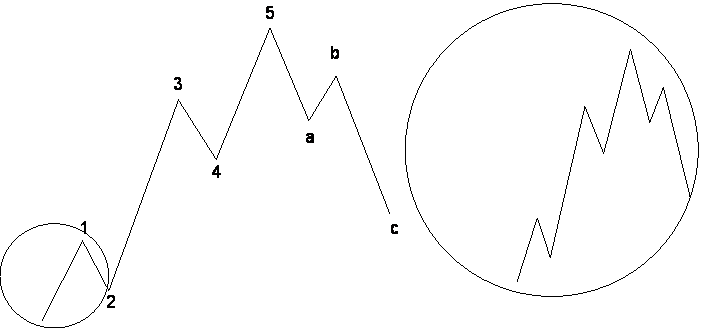
Go to the Prior Tip Neural
Network Control System for Steam Injection
Go to the Next Tip Geometric Mean and
Harmonic Mean
Return to MaxValue Home Page
Recently, my interest in chaos theory has been rekindled, and I remembered having this book on my shelf.
Chaos theory is about finding underlying order in apparently random behavior. Data that appear disordered or chaotic are sometimes the result of rather simple deterministic systems with nonlinear feedback. The best-known elements of chaos theory are:
People interested in chaos theory should read the best-selling book, Chaos: Making a New Science by James Gleick (1988).
Bill Williams (a PhD in psychology) claims discovery of the underlying fractal nature of Elliott waves. Ralph Elliott wrote a book about stock investing, The Wave Principle, in 1938. Elliott waves are embraced by many technical analysts as a way to understand behavior in stock, commodity and currency markets.
Williams says the predominant Elliott wave sequence is "basic rhythm of 'fives' corrected by 'threes'" (p. 105). For example, starting from a bottom, a stock will have a "wave" up, then a first correction, another wave up, a second correction, and then a final wave up to the top. Then, falling, there will be a wave down, a retracement up, and a final wave down to the next bottom. Inspecting a two-wave series in more detail (as in the circle in the figure, left), reveals the same 5-3 wave series (in the circle right). This is the supposed fractal nature of price movements. Further, the typical reversals exhibit the .618 "Golden Ratio" of Fibonacci numbers (1, 3, 5, 8, 13 ...).

If only profitable stock trading could be this simple! Of course, Williams shows examples in his book to support his wave series premise. In looking at lots of stock histories, I seldom see the pattern. Therefore, I must be counting (the waves) wrong!
Bill Williams claims 35 years of successful trading, presentations to 20,000 people, and having personally trained over 450 successful traders. In end chapters, he describes behavior in terms of three human body shapes and how trading styles should be compatible.
Despite my skepticism, there are some interesting ideas in the
book. He reports that his team invented the market facilitation index:
MFI = Range / Volume
which is the price change per unit time. This is a measure "of the
market's willingness to move the price" and a key indicator of whether a
direction change is real.
I was put off by the frequent use of his company trademarks (like "Profitunity Trading Partner") and some wrong science assertions (e.g., the brain's left hemisphere processes at a mere 16 bits per second). Nonetheless, I am actively searching for effective trading patterns and hope that some of the ideas in the book will prove worthy. There is an ample bibliography.
—John Schuyler, December 2004.
Copyright © 2004 by John R. Schuyler. All rights reserved. Permission to copy with reproduction of this notice.